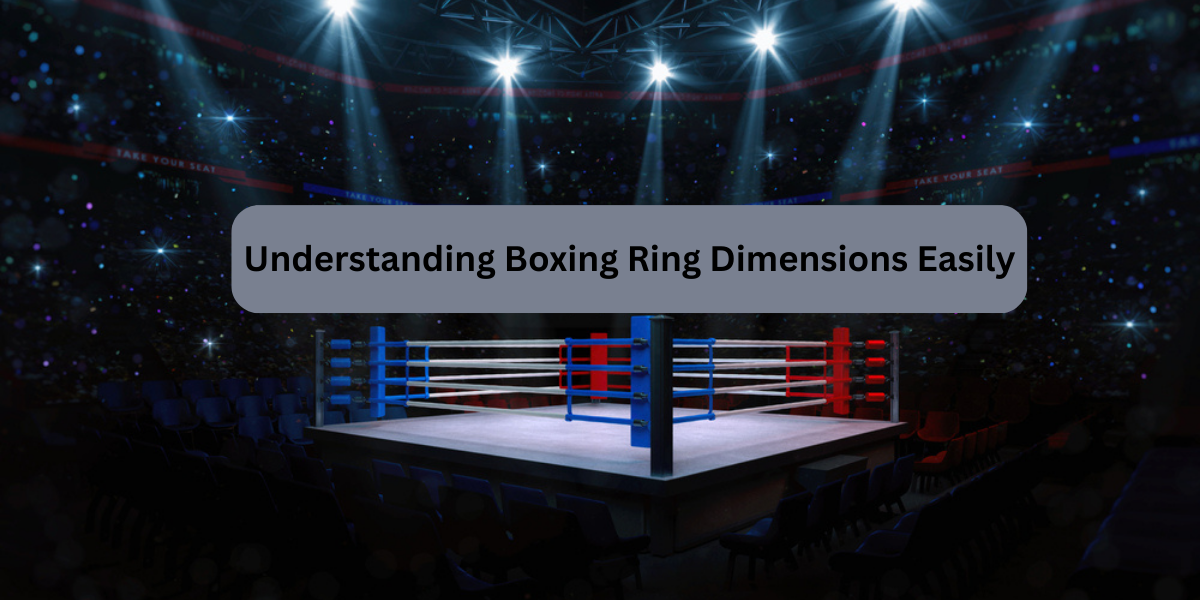If you’ve ever watched a boxing match and wondered how big the ring is or why the size even matters you’re not alone. Whether you’re a fan, a beginner in the sport, or setting up your own gym, understanding boxing ring dimensions is key to appreciating the game and training effectively.
Boxing Ring Dimensions Easily is a square platform where matches take place. Inside the ring, the fighting area is usually 20 feet (6.1 meters) wide from rope to rope. Around this, there’s an extra 2 feet (0.61 meters) of space on all sides, called the apron, where trainers and officials stand. When you include this outer area, the full size of a boxing ring is about 25.6 feet by 25.6 feet (7.8 meters by 7.8 meters).
In official AIBA boxing competitions, the ring is 6.1 meters wide inside the ropes. Around the fighting area, there’s an extra space called the apron that stretches about 85 cm on each side. This includes extra canvas used to keep everything tight and secure. The ring is also raised, standing about 1 meter (100 cm) above the ground.
In this guide, we’ll break it all down in plain English. You’ll learn how big a boxing ring is, what affects its size, and how dimensions can influence a match. From professional bouts to amateur setups, we’ll make everything simple, clear, and useful.
What Is a Boxing Ring?

Despite the name, a boxing “ring” is actually a square platform enclosed by ropes. The term “ring” is a historic nod to the early days of bare-knuckle boxing when fighters squared off inside a circle drawn on the ground.
Modern boxing rings are built with strict guidelines, especially for official matches. But not all rings are created equal dimensions can vary depending on the level of competition and the organization overseeing the match.
Standard Boxing Ring Dimensions (Professional)
For most professional boxing events, the dimensions follow standards set by organizations like the World Boxing Association (WBA) or International Boxing Federation (IBF).
Professional Ring Size:
- Inside the ropes: 16 to 20 feet square
- Outside edge to edge (including apron): About 20 to 24 feet
- Ring height from the floor: 3 to 4 feet
- Rope height: 4 ropes spaced 12 to 14 inches apart, starting at around 18 inches from the floor
📌 Note: The exact size may vary slightly by venue, but 20×20 feet inside the ropes is one of the most common sizes in pro boxing.
Amateur Boxing Ring Dimensions
For amateur bouts—such as those held under the International Boxing Association (AIBA)—the ring dimensions tend to be smaller and more standardized for consistency and safety.
Amateur Ring Size:
- Inside the ropes: 16 to 20 feet
- Outside measurement (including apron): Up to 24 feet
- Ring height: 3.3 to 4.3 feet
- Number of ropes: 3 or 4 depending on the organization
This smaller space helps amateur boxers stay close, engage more, and develop their techniques more efficiently in training and competition.
Training and Home Boxing Rings
If you’re building a boxing ring for personal use like at a home gym or training facility the size can be more flexible.
Typical Training Ring Sizes:
- Small gyms: 12×12 to 16×16 feet inside the ropes
- Home setups: Even smaller, depending on space
- Ceiling height: Ideally 10 feet or more to accommodate footwork and jumping exercises
These rings are usually simpler in construction but still offer a great platform for sparring and practice.
What’s Around the Ring?
A boxing ring isn’t just about the fighting space. Several other components are essential:
- Apron: The area outside the ropes, usually 2 feet wide, used by trainers and referees
- Canvas: The floor of the ring, covered with non-slip fabric
- Turnbuckles: Padded corners that help secure the ropes
- Ring posts: Hold the ropes and structure together
All of these parts are regulated for safety, especially in professional rings.
What Materials Are Used in a Boxing Ring?
Building a boxing ring involves several key materials:
- Steel or hardwood base: Provides strength and structure
- Shock-absorbing padding: Protects athletes during falls
- Non-slip canvas cover: Prevents slipping during movement
- High-tension ropes: Made of cable or synthetic material wrapped in padding
Quality materials help reduce injury risk and provide the best training environment.
Why Ring Size Matters
You might wonder—why not just use the same ring size for everyone?
The truth is, ring size affects strategy and performance. Here’s how:
- Larger rings favor boxers who like to move and keep their distance.
- Smaller rings force more action and favor aggressive fighters.
- Taller ropes can provide better support during clinches and corner work.
- Wider aprons offer more space for coaches and cutmen between rounds.
So when you’re choosing or setting up a ring, consider what style of boxing you’re supporting.
Common Questions About Boxing Ring Dimensions
1. How big is a boxing ring in feet?
- Most professional rings are 20 feet by 20 feet inside the ropes, with an outer size of up to 24 feet.
2. Are all boxing rings the same size?
- No, ring sizes vary depending on whether it’s for professional, amateur, training, or home use.
3. How high is a boxing ring from the ground?
- Generally, a boxing ring is 3 to 4 feet high from the floor to the ring platform.
4. How wide is the space between ropes?
- The ropes are typically 12 to 14 inches apart, starting about 18 inches above the mat.
Tips for Setting Up Your Own Boxing Ring
Thinking of building your own ring? Here are a few quick tips:
- Measure your space first: Choose a size that fits your room but allows movement around the ring.
- Use shock-absorbing padding: Protects from injuries during falls.
- Install strong corner posts and ropes: Safety first!
- Keep ceiling height in mind: Aim for at least 10 feet to allow jumping and tall fighters.
Conclusion: Know the Ring, Know the Game
Understanding boxing ring dimensions isn’t just for gym owners or referees it’s for anyone who loves the sport. From training to watching a professional match, knowing how the ring works can give you a deeper appreciation for the strategies and action inside.
Whether you’re a fan, fighter, or fitness enthusiast, we hope this guide made the topic easy to understand. If you’re looking to learn more about boxing equipment or setting up your own space, check out our related guides [insert internal link here].

